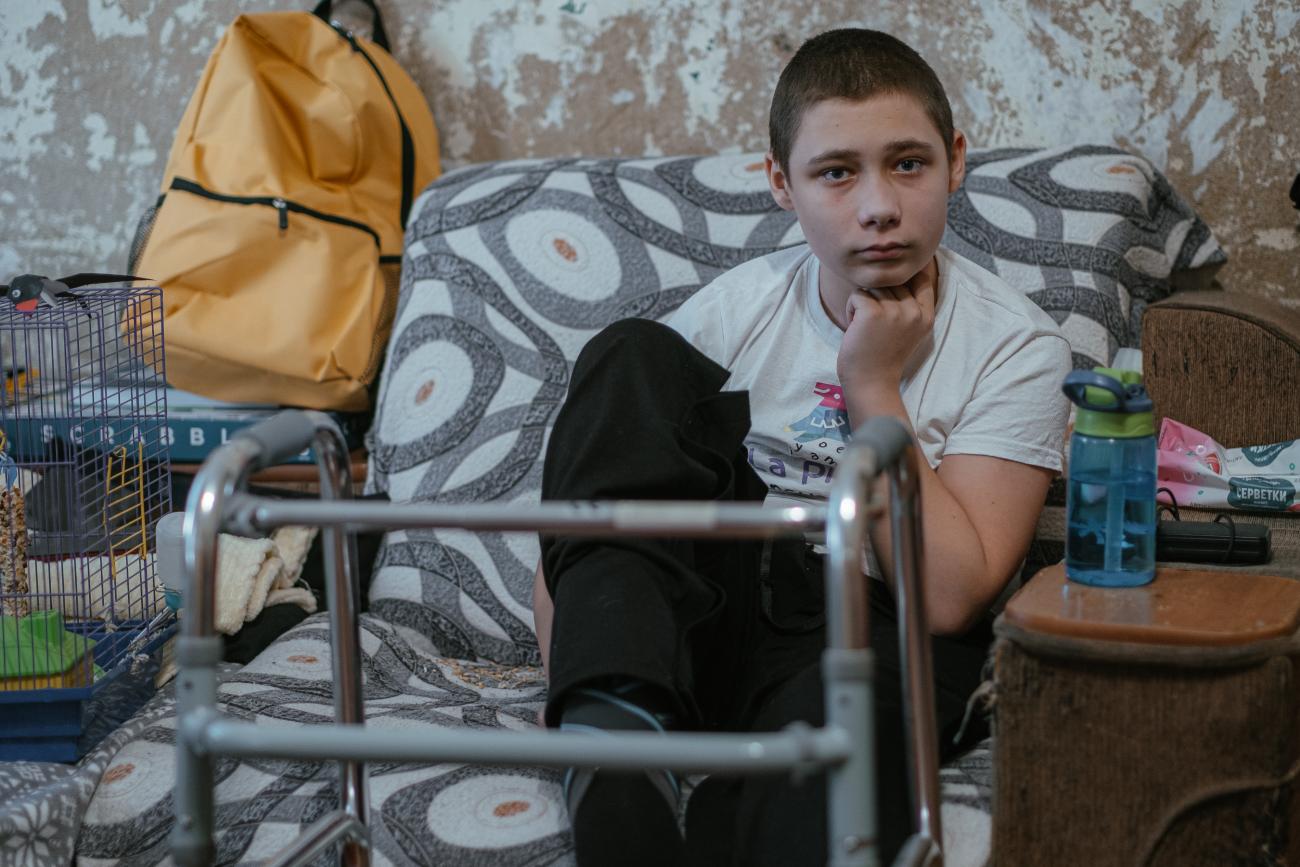In Ukraine, teenager starts his physical and mental recovery after amputation

Thirteen-year-old Nazar from Kharkiv region was injured by an unexploded explosive device while walking with a friend in his village, his long road to recovery
Nazar’s thirteenth birthday celebration earlier this year was not what he dreamed of, to welcome his teenage years at home with family and friends. Instead, he spent it in a hospital ward, which has become his second home for the last few months.
Nazar remembers 4 November 2024 as just an ordinary Monday morning. He finished his online school lessons and went for a walk with a friend close to home. "It was beyond the highway,” recalls Nazar. “I don't even remember where exactly we were going.” Nazar’s friend spotted an object on the ground and kicked it. The object was unexploded ordnance.
The explosive device detonated. Nazar sustained leg injuries, and his friend was injured in the torso. Their mobile phones were thrown from them, but Nazar managed to crawl through the mud with injured legs to grab his device and call for help.
"We received a call saying that he had called an ambulance, saying his legs were torn off. The ambulance didn't believe him at first,” says Yevheniia, Nazar’s mother.

Nazar was taken to the nearest hospital in the town of Barvinkove. There, he was given immediate assistance and then referred to a more specialized hospital in Kharkiv city, a three-hour drive away.
"The first month was difficult because we were not given any predictions,” says Yevheniia. “They said we had to monitor the condition of the soft tissues. If everything was fine, then it was fine, but if necrosis started, they would partially amputate.”
In total, Nazar underwent 14 surgeries, having suffered fractures, deep shrapnel wounds and hemorrhagic shock. He had to have part of his right foot amputated. Since that horrific late November day, Nazar has only been home twice in-between treatments.
"Rehabilitation has just started for us,” says Yevheniia. “The first surgery was when we arrived at the hospital. Then there were two more surgeries – skin grafts. Just two weeks ago, the plates were removed, and the rehabilitation stage began.”
On his most recent trip home, Nazar arrived with crutches and a walker. After the injury, Nazar could only sit or lie down but now, with the help of the walker, he is taking his first steps and learning to walk again.

His physical recovery is underway, but the mental scars also require significant support and time to heal.
"When we first arrived to see Nazar, he was not really willing to talk,” says Olena Hunchenko, a case manager from the International Rescue Committee. “Probably, it was a child's reaction to what had happened. During the next visits, Nazar became more open, talking about his studies, hobbies, and even sharing some moments of the incident.”
Olena says she learned about Nazar’s injury from the news and then found Yevheniia’s contact information the same day and called to offer support. Cash assistance, mental health and psychosocial support and rehabilitation aids, including crutches and a walker, have been provided within the UNICEF and International Rescue Committee supported programme on child-focused survivor assistance, funded by the EU. This support will enable Nazar’s recovery and support Yevheniia and the family to better cope with the additional needs that he has following the accident.
Nazar explains that, before his injury, he took lessons on mine safety at school, but he did not think his village could be contaminated with explosive remnants of war and mines. However, his home in Nikopol is close to the front line and often impacted by shelling – leaving unexploded devices in locations where they pose high risk to people, in particular children.
“The threat of explosive ordnance can be hidden anywhere—even in places that seem familiar or harmless. That’s why our education efforts focus on instilling clear and practical safety rules in children and young people: never approach or touch unknown objects, always tell a trusted adult right away, and report the danger by calling 101,” explains Svitlana Kisilova, Social Behaviour Specialist at UNICEF Ukraine.
Now Nazar studies online again and reads books on a new tablet that he received through the child focused victim assistance programme. He says he is good at maths and, before his injury, he loved playing football with friends.
In a few weeks, Yevheniia and Nazar will return to the hospital in Kharkiv to continue rehabilitation.
Case manager Olena says that, unfortunately, Nazar is not the only child in Kharkiv region who she has supported after an injury. "I have many cases of injured children, more than 30,” says Olena. “These are injuries from various unexploded explosive devices including from shelling in Kharkiv itself.”
To support children who have suffered accidents caused by mines or other explosive weapons in Ukraine, a holistic child focused victim assistance programme was launched by UNICEF in 2024, in partnership with the International Rescue Committee, with the support of the European Union's Directorate-General for Civil Protection and Humanitarian Aid (ECHO). Nazar is one of 570 children who have received critical assistance under this programme to ensure tailored support for their long-term recovery.



